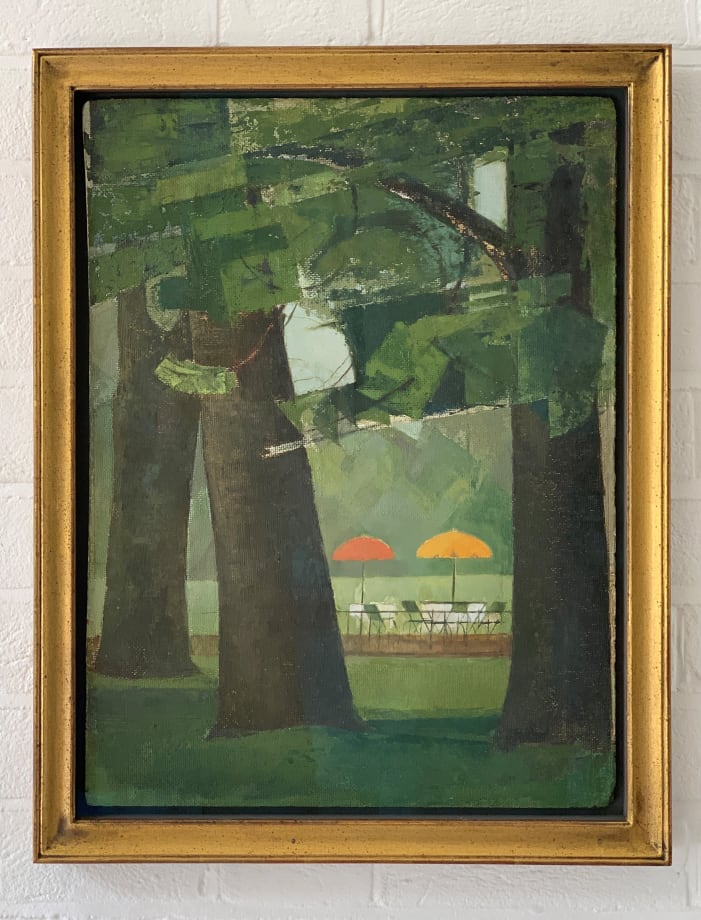James Hyman, one of London's major dealers in modern British art, has curated a special presentation of iconic twentieth-century British paintings. At the heart of the display is Michael Andrews' enormous Colony Room Mural, 1958 [Oil on Canvas, 263 x 377 cm (103.36 x 148.16 inches)].
Michael Andrews Colony Room Mural is an icon of British cultural history by one of the most important British artists of the twentieth century. Painted on canvas, this picture was installed at the famous Colony Room Club in Soho for half a century until its closure in 2008. After cleaning off years of nicotine stains, the painting is revealed in its original glory. This small club was at the heart of London's creative life. In the 1950s and 1960s, it was a meeting place for Michael Andrews and his School of London friends Frank Auerbach, Francis Bacon and Lucian Freud, and in the 1990s was given new life by Damien Hirst, Sarah Lucas and the YBAs. Paintings by Andrews, especially large ones such as this, are very rare. In all he produced fewer than two hundred paintings, leading his friend Lucian Freud to declare that Andrews only painted masterpieces.
London is also the subject of one of Leon Kossoff's greatest late landscapes, the magisterial painting Kings Cross, Summer, 1998, [Oil on board, 183 x 193 cm (71.92 x 75.85 inches)]. Another London picture with a significant geographical association is R.B. Kitaj's If Not, Not (study for British Library Tapestry), 1992 [98 x 98 cm (hand woven tapestry 38.51 x 38.51 inches)]. This beautiful test section for the famous British Library tapestry is based on one of Kitaj's most famous works, the painting If Not, Not, and was handwoven by the world-renowned Dovecot Tapestry Studio.
Another large-scale highlight is one of the largest paintings ever made by Ivon Hitchens, The Fountain of Acis, 1964. [Oil on canvas, 238 x 198.5 cm (93.53 x 78.01 inches)]. On the theme of eternal love, the picture was, appropriately, commissioned by a husband to give to his wife. This huge painting is one of the largest and most ambitious works Hitchens ever painted. The Fountain of Acis rivalled the scale of the latest American painting and reaffirmed the artist's status at the forefront of the British avant-garde. Sharing the theme of love is Patrick Caulfield's major early painting, the romantic Three Roses, 1963 [Oil on board, 157 x 150 cm (61.70 x 58.95 inches)]. Caulfield combines the romance of roses with a diamond motif to create one of his sexiest paintings of the 1960s. The art writer Marco Livingstone has explained that 'Three Roses was painted as a wedding present for some friends, and it partakes deliberately of the festive tone and even - rather dangerously for a modernist artist - of the sentimentality of a congratulatory greetings card'.
In contrast, also presented will be three major paintings by Peter de Francia, the centenary of whose birth falls in 2021. As with his famous Disparates drawings, these rare paintings have a challenging immediacy despite their at times complex iconography, and their political message has a particular urgency in today's troubled times.
The presentation will also include other major works: figure paintings by Tony Bevan; photographs by Bill Brandt deaccessioned by MoMA, New York; an important sculpture by Prunella Clough; a rare Kitchen-sink period painting by Derrick Greaves; a collage by Nigel Henderson; a stripe gouache by Bridget Riley; and a sublime blue and brown abstraction by William Scott.









